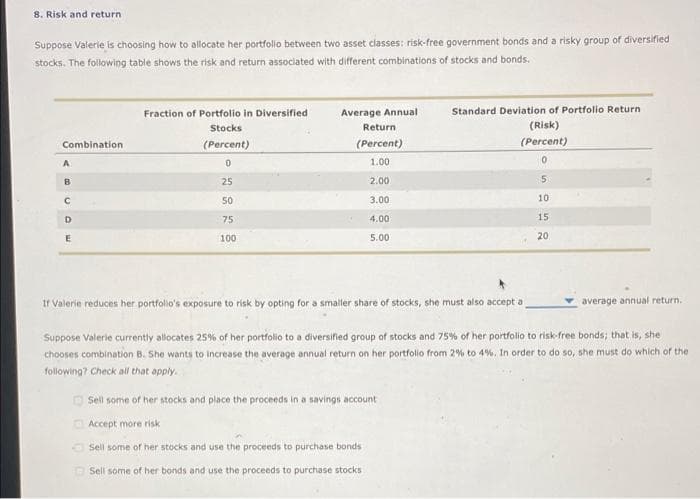Suppose Valerie is choosing how to allocate her portfolio between two asset classes: risk-free government bonds and a risky group of diversified stocks. The following table shows the risk and return associated with different combinations of stocks and bonds. Fraction of Portfollo in Diversified Average Annual Standard Deviation of Portfolio Return Stocks Return (Risk) Combination (Percent) (Percent) (Percent) 1.00 B. 25 2.00 50 3.00 10 D 75 4.00 15 100 5.00 20 If Valerie reduces her portfolio's exposure to risk by opting for a smaller share of stocks, she must also accept a average annual return. Suppose Valerie currently allocates 25% of her portfollo to a diversined group of stocks and 75% of her portfolio to risk-free bonds; that is, she chooses combination B. She wants to increase the average annual return on her portfolio from 2% to 4%. In order to do so, she must do which of the following? Check all that apply. Sell some of her stocks and place the proceeds in a savings account
Suppose Valerie is choosing how to allocate her portfolio between two asset classes: risk-free government bonds and a risky group of diversified stocks. The following table shows the risk and return associated with different combinations of stocks and bonds. Fraction of Portfollo in Diversified Average Annual Standard Deviation of Portfolio Return Stocks Return (Risk) Combination (Percent) (Percent) (Percent) 1.00 B. 25 2.00 50 3.00 10 D 75 4.00 15 100 5.00 20 If Valerie reduces her portfolio's exposure to risk by opting for a smaller share of stocks, she must also accept a average annual return. Suppose Valerie currently allocates 25% of her portfollo to a diversined group of stocks and 75% of her portfolio to risk-free bonds; that is, she chooses combination B. She wants to increase the average annual return on her portfolio from 2% to 4%. In order to do so, she must do which of the following? Check all that apply. Sell some of her stocks and place the proceeds in a savings account
Chapter13: Capital, Interest, Entrepreneurship, And Corporate Finance
Section: Chapter Questions
Problem 4.8P
Related questions
Question

Transcribed Image Text:8. Risk and return
Suppose Valerie is choosing how to allocate her portfolio between two asset classes: risk-free government bonds and a risky group of diversified
stocks. The following table shows the risk and return associated with different combinations of stocks and bonds.
Fraction of Portfolio in Diversified
Average Annual
Standard Deviation of Portfolio Return
Stocks
Return
(Risk)
Combination
(Percent)
(Percent)
(Percent)
1.00
B
25
2.00
5.
50
3.00
10
75
4.00
15
100
5.00
20
If Valerie reduces her portfolio's exposure to risk by opting for a smaller share of stocks, she must also accept a
average annual return.
Suppose Valerie currently allocates 25% of her portfollo to a diversined group of stocks and 75% of her portfolio to risk-free bonds; that is, she
chooses combination B. She wants to increase the average annual return on her portfolio from 2% to 4%. In order to do so, she must do which of the
following? Check all that apply.
O Sell some of her stocks and place the proceeds in a savings account
O Accept more risk
Sell some of her stocks and use the proceeds to purchase bonds
Sell some of her bonds and use the proceeds to purchase stocks
Expert Solution
This question has been solved!
Explore an expertly crafted, step-by-step solution for a thorough understanding of key concepts.
This is a popular solution!
Trending now
This is a popular solution!
Step by step
Solved in 2 steps

Knowledge Booster
Learn more about
Need a deep-dive on the concept behind this application? Look no further. Learn more about this topic, economics and related others by exploring similar questions and additional content below.Recommended textbooks for you


Microeconomics: Principles & Policy
Economics
ISBN:
9781337794992
Author:
William J. Baumol, Alan S. Blinder, John L. Solow
Publisher:
Cengage Learning

Brief Principles of Macroeconomics (MindTap Cours…
Economics
ISBN:
9781337091985
Author:
N. Gregory Mankiw
Publisher:
Cengage Learning


Microeconomics: Principles & Policy
Economics
ISBN:
9781337794992
Author:
William J. Baumol, Alan S. Blinder, John L. Solow
Publisher:
Cengage Learning

Brief Principles of Macroeconomics (MindTap Cours…
Economics
ISBN:
9781337091985
Author:
N. Gregory Mankiw
Publisher:
Cengage Learning

Essentials of Economics (MindTap Course List)
Economics
ISBN:
9781337091992
Author:
N. Gregory Mankiw
Publisher:
Cengage Learning

Principles of Macroeconomics (MindTap Course List)
Economics
ISBN:
9781285165912
Author:
N. Gregory Mankiw
Publisher:
Cengage Learning

Principles of Macroeconomics (MindTap Course List)
Economics
ISBN:
9781305971509
Author:
N. Gregory Mankiw
Publisher:
Cengage Learning